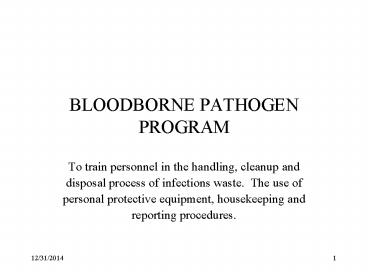BLOODBORNE PATHOGEN PROGRAM PowerPoint PPT Presentation
1 / 12
Title: BLOODBORNE PATHOGEN PROGRAM
1
BLOODBORNE PATHOGEN PROGRAM
- To train personnel in the handling, cleanup and
disposal process of infections waste. The use of
personal protective equipment,
housekeeping and reporting procedures.
2
DEFINITIONS
- Biological Hazards
- Biohazard is an infectious agent that presents a
risk,or potential risk, to the well being of
personnel - Medical / Infectious Waste
- Human or animal tissue, blood or blood products
or fluids. This includes bandages, syringes,
sharps and material used in the cleanup of
biohazards - Universal Precautions
- The process used to control direct contact with
body fluids or infectious material and prevent
them from coming into contact with the body - Hazards
- Unprotected exposure to body fluids - where the
possible risk of infection from Hepatitis and HIV
are possible
3
DEFINITIONS (continued)
- Hazard Controls
- Engineering Controls - prevention of exposure to
bloodborn pathogens these controls include proper
storage facilities, containers, disinfectant
equipment cleanup equipment - Administrative Controls - include universal
precautions, assignment of PPE, training, use of
spill kits, waste collection and disposal
procedures - Reporting Record Keeping - EHS will maintain
all reports - Training Certificates
- Notice of HBV vaccinations - exposure reports -
30 years - Occupational contracted HBV or HIV- OSHA 200 log
- Human Fluids semen, vaginal secretions,
cerebrospinal fluid, saliva fluid ( dental) or
any body fluids that visibly contain blood
ie..vomit
4
Hepatitis - B Virus (HBV) Vaccinations
- Personal required to provide first aid, emergency
response duties or duties that may expose them to
bloodborne pathogens will be offered the HBV
vaccination. - at no expense to the employee
- within 10 days of assignment
- employee may refuse - or - request at a later
date - offer must be documented
- after exposure - three shots
5
Post Exposure Treatment Notification Procedures
- Affected employee or Good Samaritan exposed to
HIV/HVC/ HBV will report exposure to the
University Medical Department - University Medical will contact the exposure
source - Work related injury - total care
- Must report within 24 hours
- Provide initial blood test - free
- zero-negative re-tested at 6 weeks, 12 weeks and
6 months - and follow Dr. orders - Everything is confidential
- request that person be tested - not mandatory -
refusal no impact on employment - tested for HIV or HBV after consent
- results provided to exposed/source within 5
working days. - Should start vaccination process
6
Blood Exposure Cuts
- Exposure to blood or blood products
- Needle stick, cut, or mucous membrane exposure to
anothers body fluids - An Occupational Exposure
- Is defined as blood or body fluid contact from an
injured or ill person to the affected employee or
injury by a contaminated sharp object. - first aid
- decon / clean-up process
- daily routine
- MUST IMMEDIATELY REPORT to the University Medical
Department. Possible Hepatitis B Vaccination - MUST IMMEDIATELY REPORT to the University Medical
Department - The purpose is to protect the health and safety -
of those directly involved
7
GENERAL PROCEDURES
- Personnel must adhere to the following
procedures - Supervisors must ensure that employees are
trained in - universal precautions, PPE, proper clean-up and
disposal techniques - no eating, drinking, smoking, applying
cosmetics/lip balm or handling contact lenses - never store food or beverages in refrigerators
- personal hygiene after possible exposure
- immediately after removal of PPE
- shower
- hand washing 5 minutes
- when the employee has cuts, chapped hands,
dermatitis or similar conditions - PPE storage, washing, decontamination or disposal
- contaminated clothing or PPE must never be worn
outside of area - perform procedures to minimize splashing and
contact
8
WASTE DISPOSAL PROCEDURES
- Infectious waste must be segregated at point of
origin - sharps in puncture proof container
- fluids in BIOHAZARD bags
- containers must be labeled BIOHAZARD with emblem
- University Medical Center is the waste disposal
sight - Decontamination procedures is bleach and water
mixed 1 to 4. - all surrounding areas
- Never dispose of infectious material into the
sewage system - Infectious agents must be disinfected be for
disposal
9
PERSONAL PROTECTIVE EQUIPMENT FOR WORKERS
PROTECTION
- Against HIV and HBV Transmission
- Task Gloves Apron Mask Eyewear
- Control of bleeding w/ spurting blood X
X X X - Bleeding control with minimal bleeding X
- Emergency Child Birth X X
X X - Blood Drawing X
- Handling Cleaning Instruments X
- Cleaning Bio Spills X
- Taking Temperature
- Giving Injection X
- Measuring Blood Pressure X
10
BLOOD FLUID SPILL DECON - CLEAN-UP PROCEDURES
- Clear the area - Do Not allow unauthorized
personnel in the area - Remove all items from the spill kit
- Mix bleach and water 1 to 4 ratio
- Put on all PPE, mask and eye protection, booties,
gloves - Apply bleach solution to all contaminated areas
- Apply Red Z to all contaminated areas - let
stand 10 min. - Open Biohazard bag scoop contaminated fluids
into bag - using scope - Wipe-up excess with towel - put into bag
- Repeat bleach solution wipe-up solution with
second towel - put into bag
11
BLOOD FLUID SPILL CLEAN-UP PROCEDURES
(continued)
- Inspect area to ensure that all fluids have been
removed - If wearing booties remove first Do Not touch
shoes - dispose of in bag - Next remove gloves - dispose of in bag
- Remove face eye protection - dispose of in bag
- Close and secure bag with tie-tie
- Wash hands for five minutes with anti-bacteria
soap - Wipe hands with alcohol wipes
- Deliver waste to the University Medical
Department - NOTE No smoking, eating, drinking, applying
cosmetics or working with contact lenses during
clean-up operations
12
BLOOD FLUID SPILL CLEAN-UP PROCEDURES
(continued)
- Soiled feminine hygiene/sanitary napkins, soiled
tissues, etc are not considered a biohazard or
medical waste

